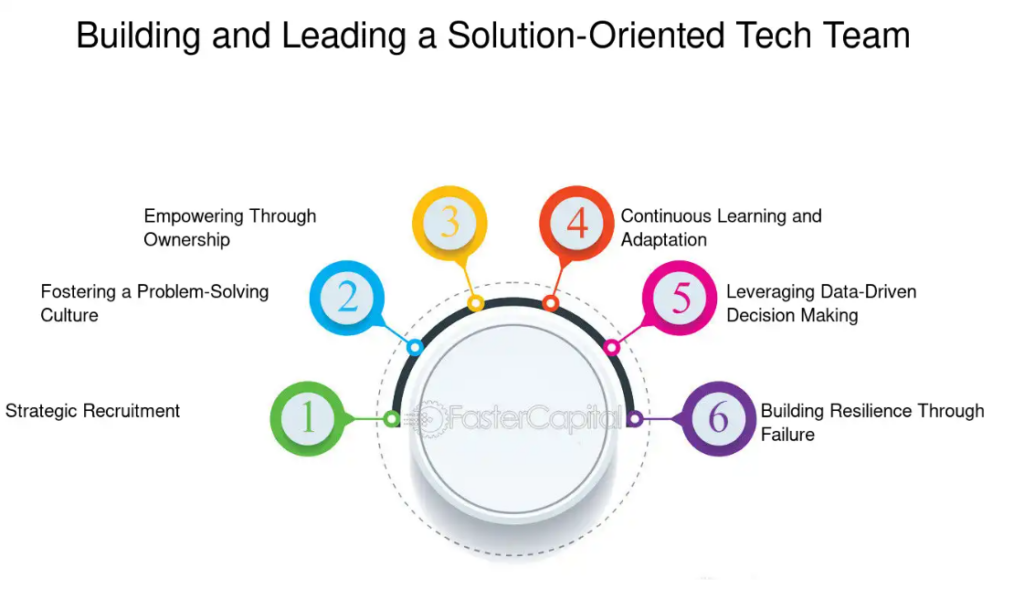Article

Amazon’s Principles for Building a High-Performance Tech Team
Building and leading a high-performing tech team is both a challenge and an opportunity in the competitive realm of technology. The success of a tech team is not solely reliant on cutting-edge technologies or innovative solutions but on the strength of its leadership. One company that has mastered the art of leading high-performance teams is Amazon.
Known for its relentless pursuit of excellence, Amazon’s leadership principles offer a blueprint for cultivating teams that excel in innovation, agility, and performance. This article delves into each principle, providing actionable strategies for tech leaders to enhance their team’s performance and adapt to the evolving technological landscape.

[Image Source: Preplaced- LinkedIn]
Decoding Amazon’s leadership approach to build a high-performance tech team
Amazon’s leadership principles are more than corporate jargon; they represent a robust framework for achieving superior performance and innovation. Let’s dissect each principle and explore practical ways to apply them to tech teams, highlighting how they foster a culture of high performance and adaptability.
1. Customer obsession: The cornerstone of high-performance
Amazon’s commitment to “Customer Obsession” is not just a strategic priority but a cultural cornerstone. This principle permeates every facet of Amazon’s operations, especially within Amazon Web Services (AWS). The AWS team exemplifies this principle by deeply engaging with customer needs and feedback to develop and refine its services.
AWS’s approach to customer obsession is a masterclass in leveraging feedback for innovation. For instance, the development of Amazon S3 and AWS Lambda showcases how deeply the team delves into customer usage patterns and feedback. These innovations were not born from isolated brainstorming sessions but from a continuous dialogue with users, coupled with a deep understanding of their evolving needs.
AWS fosters a culture of collaboration where ideas are constantly cross-pollinated. This process involves bringing together diverse perspectives and expertise to create solutions that resonate with customers. Teams frequently review customer feedback and usage data to ensure that their solutions are not only cutting-edge but also practical and impactful.
2. Ownership: Cultivating a sense of responsibility
Ownership is a critical component of high-performance teams. Amazon’s principle of ownership emphasizes the importance of thinking long-term and considering the impact of decisions on the entire organization. For tech leaders, this means cultivating a culture where team members take responsibility for their work and its outcomes beyond their immediate tasks.
Sustainable work habits are essential for maintaining high performance over the long term. Agile encourages a steady, manageable pace, which helps prevent burnout and ensures consistent productivity. By balancing short-term goals with long-term objectives, tech teams can achieve sustainable success and maintain high standards of performance.
3. Invent and simplify: Driving innovation through simplicity
Innovation is at the heart of Amazon’s success. Leaders are encouraged to seek new ideas and simplify processes, even if these innovations are initially met with resistance. For tech teams, this principle means fostering an environment where experimentation and creative problem-solving are encouraged and where complexity is minimized.
Agile methodologies are inherently designed to support innovation and simplicity. Techniques such as delivering Minimal Viable Products (MVPs) and focusing on iterative development allow teams to test and refine ideas quickly. This approach reduces complexity and accelerates the delivery of effective solutions, aligning with Amazon’s commitment to continual improvement.
A culture that values diverse ideas and adaptive learning can significantly enhance a tech team’s ability to innovate. Agile practices, which promote collaboration and iterative feedback, support this by creating an environment where new approaches are welcomed and tested. This openness to external ideas and continuous adaptation drives sustained innovation.
4. Enhancing leader’s decision-making accuracy
Amazon values leaders who demonstrate strong judgment and seek out diverse perspectives to inform their decisions. For tech leaders, this principle involves utilizing empirical data and gathering input from various stakeholders to make well-rounded decisions. It’s about balancing intuition with evidence to drive effective outcomes.
Agile practices, such as sprint reviews and retrospectives, provide valuable insights into the effectiveness of decisions and strategies. By regularly assessing and refining their approaches based on real-time feedback, tech teams can enhance their decision-making accuracy and ensure that their solutions are continually improving.
The COVID-19 pandemic posed unprecedented challenges for global supply chains, and Amazon was no exception. However, the company’s adherence to its “Bias for Action” principle allowed it to navigate these challenges with remarkable agility.
During the pandemic, Amazon faced a surge in demand and logistical obstacles that threatened to disrupt its operations. In response, Amazon empowered Fulfillment Center leaders with greater autonomy to make swift decisions on the ground. This decentralization of authority was crucial in developing innovative strategies to manage the surge in online orders and ensure safe operations.
With increased decision-making authority, Fulfillment Center leaders implemented several key measures, including staggered shifts and restructured workflows to maintain social distancing. These adjustments were made quickly and effectively, ensuring that customer orders continued to be processed and delivered with minimal delay.
Reflective practices, such as Agile retrospectives, are crucial for continuous improvement. These structured opportunities for teams to review their performance and adjust their methods align with Amazon’s principle of being right often. By systematically reassessing their strategies and assumptions, tech teams can enhance their adaptability and decision-making capabilities.
5. Learn and be curious: Fostering a culture of continuous learning
Curiosity and a commitment to continuous learning are essential for high performance. Amazon’s leadership principle emphasizes the importance of exploring new possibilities and seeking improvement. For tech leaders, this means creating an environment where team members are encouraged to pursue new knowledge and skills.
Agile methodologies support continuous learning through regular feedback and iterative development. Practices such as retrospectives and incremental delivery provide teams with ongoing opportunities to learn and adapt. This focus on learning aligns with Amazon’s principles and fosters a culture of growth and innovation.
Agile’s preference for adaptability and responsiveness supports a culture of curiosity. By valuing flexibility and openness to new information, tech teams can effectively respond to changing conditions and drive continuous improvement. This mindset is crucial for maintaining high performance in a dynamic technological landscape.
6. Hire and develop the best: Building a strong talent foundation
Amazon places significant emphasis on hiring and developing top talent, and leaders are expected to elevate performance continually through strategic hiring and promotions. For tech leaders, this involves identifying exceptional talent and providing opportunities for growth and development within the organization.
Agile frameworks support skill development by promoting cross-functional teamwork and individual empowerment. By fostering an environment where team members are encouraged to take initiative and develop their skills, Agile practices align with Amazon’s focus on nurturing talent and preparing individuals for future challenges.
In Agile environments, leadership often involves acting as a facilitator and supporting team members in achieving their best work. This approach reflects Amazon’s commitment to developing leaders and providing mechanisms for career advancement. By adopting a servant-leadership mindset, tech leaders can foster a culture of growth and excellence.
7. Insist on the highest standards: Maintaining excellence
Amazon’s principle of insisting on the highest standards involves continuously raising the bar for quality and performance. For tech leaders, this means setting rigorous standards and ensuring that every aspect of the work meets or exceeds these expectations. It’s about striving for excellence in all facets of the team’s operations.
Agile methodologies support high standards through practices such as defining a “Definition of Done” and using regular feedback loops to ensure quality. By preventing defects from moving forward and focusing on continuous improvement, Agile practices align with Amazon’s commitment to delivering high-quality solutions.
Maintaining high standards requires ongoing effort and refinement. Agile’s focus on technical excellence and iterative improvement supports this by providing regular opportunities for teams to assess and enhance their work. This commitment to quality ensures that tech teams deliver superior results and achieve operational excellence.
How CTOs can implement Amazon leadership principles to build a high-performance tech team
To build high-performing tech teams, CTOs can leverage Amazon’s leadership principles as a strategic framework. These principles not only foster innovation but also create a dynamic and customer-centric work environment:
Align with customer needs
To prioritize customer needs, CTOs should ensure their teams are deeply engaged in understanding and addressing customer pain points.
Begin by regularly collecting and analyzing customer feedback through surveys, usage data, and direct interactions. Encourage your team to use these insights to drive innovation and make decisions.
Create mechanisms for continuous customer feedback loops to ensure that the products and services evolve in alignment with customer expectations.
Questions to consider:
- How can we better understand and anticipate our customers’ needs?
- What feedback mechanisms can we implement to ensure we are consistently meeting customer expectations?
- How can our development processes be adjusted to incorporate real-time customer feedback?

[Image Source: Fastercapital]
Promote decisive and agile teams
Encourage a culture where quick decision-making is valued. This involves decentralizing decision-making authority and empowering team members to act swiftly without awaiting extensive approvals. Create a safe environment for taking calculated risks by framing failures as learning opportunities rather than setbacks.
Ask yourself: How can we reduce bureaucratic barriers and promote faster decision-making? By empowering your team to make decisions and act on them quickly, you foster an agile environment that can adapt to changes and challenges more efficiently.
Questions to consider:
- What decision-making processes can we streamline to enhance agility?
- How can we create an environment where taking calculated risks is encouraged?
- What support systems can we put in place to help team members make swift decisions?
Invest in talent
A critical aspect of building high-performing teams is hiring top talent and fostering their development. Focus on recruiting individuals who not only possess exceptional technical skills but also align with your company’s values and culture.
Invest in their growth through continuous learning opportunities, mentorship, and career advancement programs. Establish clear development pathways and provide regular feedback to help team members grow in their roles and beyond.
Questions to consider:
- How can we attract and retain top talent in a competitive market?
- What development programs can we implement to enhance team members’ skills and career progression?
- How can we provide effective mentorship and support to help our team members reach their full potential?
By embedding these principles into your leadership strategy, CTOs can build tech teams that are not only high-performing but also agile and customer-focused. This approach ensures that your team continuously evolves, adapts to new challenges, and drives innovation, ultimately leading to sustained success and growth.
In brief
Building and leading a high-performing tech team requires more than technical skills; it demands a commitment to Amazon’s proven leadership principles. From customer obsession to maintaining high standards, these principles provide a comprehensive framework for fostering innovation, agility, and excellence. By integrating these principles with Agile practices, tech leaders can enhance their team’s performance, drive continuous improvement, and adapt to the ever-evolving technological landscape.